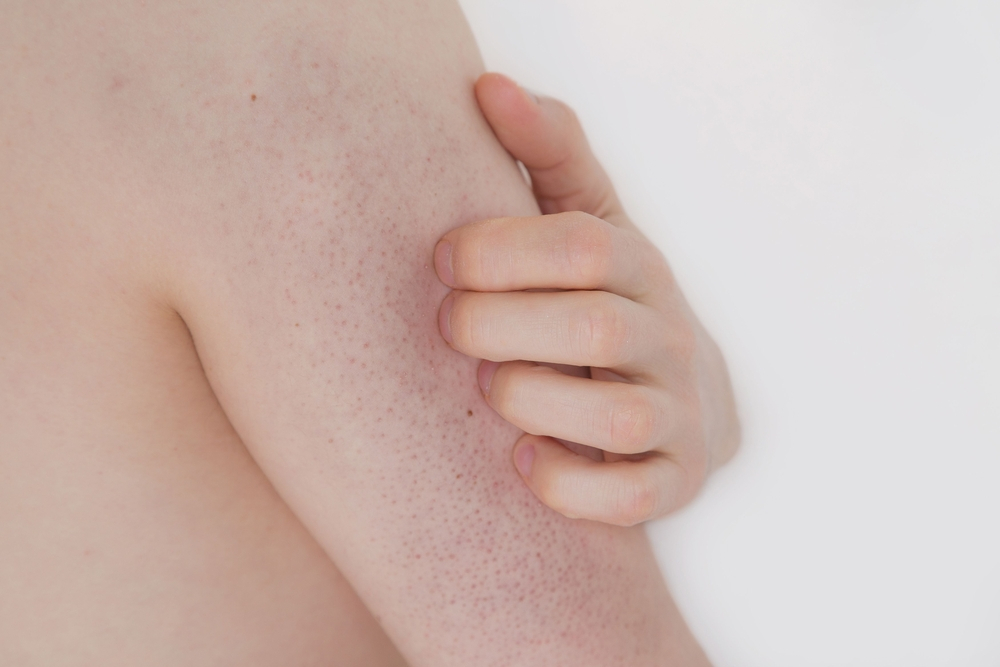Keratosis pilaris, white or red dots, on the upper arms is not particularly beautiful, but unfortunately it is a widespread cornification disorder. We explain what kind of pimples they are and what you can do against keratosis pilaris.
What is keratosis pilaris (red dots)?
Most of us will certainly be familiar with the genetic skin condition, keratosis pilaris, also known as keratosis pilarsis: these small, white or red pimples on the upper arms, legs, buttocks or even the face. They look like goose bumps and feel rough like a rubbing iron, hence the name. In the affected areas, the skin appears almost hairless. The pimples do not itch, do not hurt and in most cases simply disappear. So what are the pimples all about?
In principle, everything is quite harmless: the so-called friction skin, also called keratosis pilaris, develops when the hair follicles become clogged with keratin deposits. Instead of growing inconspicuously, sebum accumulates around even the smallest hairs. The reason: the sebaceous glands on the hair follicle become clogged. The hairs also often grow in, so that not only does a hardening of the skin cells take place, but the skin cells also become inflamed.
Factors such as stress and dry air can also make keratosis pilaris rougher.
Keratosis pilaris is particularly common in childhood and adolescence, beginning at age 10. Affected by keratosis pilaris are mainly girls and young women in puberty. As a rule, the skin disorder recedes on its own with increasing age. While some people notice the keratosis pilaris immediately and find it disturbing, others hardly notice it at all.
What are the underlying causes?
The exact cause of cornification disorder has not yet been conclusively clarified. However, it often occurs in connection with dry skin or in people suffering from skin diseases such as neurodermatitis.
It has been researched, however, that friction skin is due to an overproduction of keratin. This is a protein that gives stability to body tissue and is also a component of the outer skin layer (horny layer) and is also found in nails and hair. When keratosis pilaris appears, the keratin clumps together to form small nodules. As a result, the hair follicles can become clogged.
The chance that other family members occasionally suffer from keratosis pilaris is 30 to 50 percent.
How to treat keratosis pilaris?
Fortunately, keratosis pilaris is not contagious, but it is very likely hereditary and cannot be cured, because there is no generally effective treatment. That is why there is no patent remedy for the unsightly pimples. In most cases, however, the cornification disorder recedes over the course of the years.
If there are signs of inflammation such as reddened and warm skin as well as itching and scratching, treatment against keratosis pilaris is necessary. Thorough care several times a day is the be-all and end-all. Special moisturizing creams moisturizing ointments , peelings and oils containing salicylic acid, lactate, urea or vitamins can flush the excess keratin out of the skin and thus, if necessary, alleviate the symptoms. Urea binds moisture in the skin, effectively counteracts cornification and soothes the skin. In any case, avoid lotions, creams and etc. with fragrances and dyes.
Mild soap and moisture-binding lotions can also have a positive effect on keratosis pilaris. However, the summer months can also contribute to the improvement of rough skin due to higher humidity and sun exposure. However, the cornification disorder will not disappear completely right away. If there are no noticeable symptoms of keratosis pilaris, no treatment is necessary.
If you experience additional symptoms besides keratosis pilaris in adulthood, or if there is no cure in sight, you should see a dermatologist for an examination to make sure there is no other condition present.
The following tips can also help against keratosis pilaris
Be sure to try several treatments for keratosis pilaris, because every body is and reacts differently.
- Peeling with sea salt: Peelings gently remove dead skin cells and at the same time care for the skin. Especially in the case of keratosis pilaris, however, should not be used too often and only sparingly, so that the skin is not unnecessarily additionally irritated.
- Sauna: Those affected report that regular sauna sessions help against keratosis pilaris. Sweating and detoxifying the body improves the skin’s appearance. In some saunas, it is also common to exfoliate with salt, for example, as the skin is well softened.
- Solarium: In summer, keratosis pilaris is usually improved by exposure to sunlight, which is of course lacking for those affected, especially in the cold months. Solarium visits can provide relief. However, this is to be enjoyed only with caution, after all, the artificial sun promotes premature aging of the skin and the risk of developing cancer is increased.
- Nutrition: A balanced diet with lots of vitamins and nutrients as well as drinking enough (at least two liters a day and preferably water) is indispensable for a radiantly beautiful skin and thus also for keratosis pilaris.

